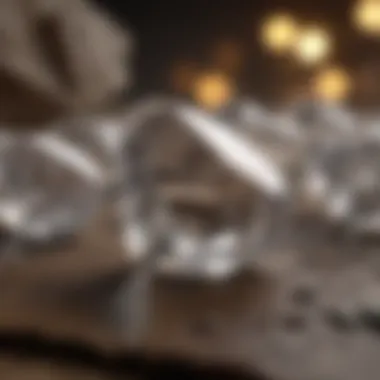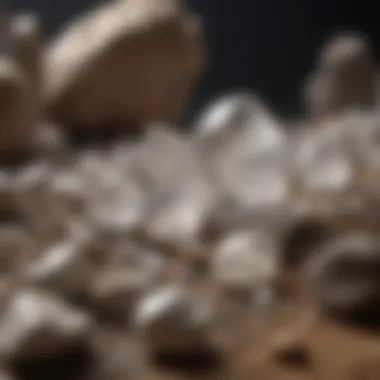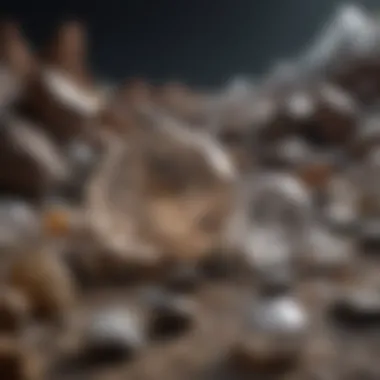Exploring Quartz Rock Market Dynamics and Valuation


Intro
The market dynamics of quartz rocks present an intricate tapestry that reflects not only geological formations but also human interests, investments, and cultural significance. This article aims to shed light on the multifaceted nature of quartz rocks, encompassing their valuation and factors that influence pricing. In addition, we will explore their applications across various industries and provide insights for collectors and enthusiasts who seek to understand these geological wonders more deeply.
Importance in Collecting and Investing
Quartz has long fascinated collectors due to its aesthetic appeal and unique properties. Understanding the market dynamics is crucial for those looking to invest in these natural specimens. The appreciation of quartz extends beyond mere aesthetics; it also includes its practical applications in technology, jewelry, and art. Thus, comprehending the nuances of this market can yield substantial rewards for both collectors and investors alike.
Preface to Quartz Rocks
Quartz rocks hold significant value in both natural science and market dynamics. It is vital to understand what quartz is and why its various forms are essential to many industries. Quartz is a mineral composed of silicon dioxide (SiO2), with its crystalline structures playing a crucial role in a variety of applications.
In this article, we will delve into the importance of quartz rocks in the context of market valuation. The primary focus will be on the types of quartz, their widespread applications, and the factors influencing their pricing. Understanding these elements can help enthusiasts make informed decisions about purchasing or collecting quartz.
The role of quartz in technology cannot be overlooked. It is a key component in electronics, such as resonators and oscillators, enhancing its market demand. Additionally, quartz is highly valued in the jewelry and decorative stone markets due to its aesthetic appeal.
The versatility of quartz is another aspect to consider. From common varieties to rare forms, there is a wide range of quartz rocks to explore. Each type comes with its unique characteristics. This exploration provided in this article is beneficial for collectors and investors alike. It can guide them in recognizing not only the physical properties but also the market trends associated with quartz.
As we proceed in this article, we will highlight crucial aspects of quartz pricing, its historical significance, and how modern technology is shaping its market dynamics. By doing so, we aim to equip readers with the knowledge they require to navigate the quartz market effectively.
"[Quartz's] unique properties have led to its extensive use in various industries, driving both demand and value over time."
Understanding quartz rocks allows for better investment decisions, ensuring collectors are aware of what influences pricing and valuation in this dynamic market.
Historical Context of Quartz
Understanding the historical context of quartz is essential. This section illustrates how quartz has shaped societies and industries throughout history. Insights into early uses and cultural significance provide a foundation for understanding its current market dynamics. The value attributed to quartz is not only in its physical properties but also in its historical journey.
Cultural Significance
Quartz has long held a valuable place in various cultures around the world. In ancient societies, its clarity and beauty made it a preferred material for crafting jewelry and ornaments. The Romans believed that quartz could protect them in battle; they often carried it as a talisman. In China, quartz was used in traditional medicine, where it was admired for its supposed healing properties.
Spiritual practices have also harnessed quartz's energy. Many indigenous tribes revered quartz crystals, associating them with spiritual enlightenment and communication with the divine. The historical connections to spirituality and symbolism contribute significantly to the demand for quartz today, especially among collectors and those interested in holistic practices.
Historical Uses of Quartz
The versatility of quartz makes its historical uses extensive and varied. In prehistoric times, quartz was flaked to create sharp tools and weapons. This utility laid the groundwork for future technological advancements. As time progressed, quartz found its way into the realm of art and decoration. It's utilized not only for its visual appeal but also for its workability.
In the 18th century, quartz began to play a role in clockmaking. The introduction of quartz oscillators revolutionized timekeeping, enhancing accuracy. This advancement continues to influence modern watches produced by brands like Seiko and Bulova.
The industrial revolution also saw quartz being harnessed for various building materials, reflective surfaces, and even electronics. From electronics to jewelry and art, quartz’s applications show its profound impact across multiple sectors. Understanding these facets helps in assessing the factors behind quartz’s market value today.
"The historical journey of quartz from tool-making to technology reflects its adaptability and enduring relevance."
By delving into quartz's past, collectors gain insight into its complexities. The connection between quartz's rich history and its present-day market dynamics makes this exploration vital for anyone interested in its value.
Types of Quartz Rocks
Understanding the types of quartz rocks is vital for appreciating their market dynamics. Each variety holds unique characteristics that can greatly influence its value. From the common to the rarest forms, this section will outline key insights and considerations relevant for collectors and investors in quartz.
Common Varieties
Common varieties of quartz include high-demand types such as Clear Quartz, Amethyst, Citrine, and Rose Quartz.


- Clear Quartz: Known for its clarity and versatility, clear quartz is often used in jewelry and is sought after for its metaphysical properties. The transparent aspect contributes significantly to its market presence.
- Amethyst: This purple variety is popular for its beauty and is believed to have calming properties. The rich violet tones can vary, influencing the pricing.
- Citrine: Recognized for its warm yellow to golden shades, citrine is favored in both jewelry and decor. Natural citrine tends to be more valuable than heat-treated varieties.
- Rose Quartz: Valued for its soft pink hue, rose quartz is frequently used in crafts and ornamental items. The gentle color enhances its desirability.
These varieties generally have stable demand due to their wide applications. Being familiar with them allows collectors to make informed purchasing decisions, recognizing the potential return on investment.
Rare and Exotic Varieties
On the other hand, rare and exotic quartz varieties can fetch premium prices in the market. Some notable examples include:
- Rutilated Quartz: Characterized by hair-like inclusions, it is both striking and sought after. The presence of rutile can enhance aesthetic appeal, often increasing its value significantly.
- Smoky Quartz: This brown-to-black variety is appreciated for its unique color and transparency. Variety in shades can affect its pricing.
- Ametrine: A hybrid of Amethyst and Citrine, this unique quartz shows both colors. As a result, it’s a rarer find and often comes with a high price tag due to its dual nature.
- Cherry Quartz: This man-made variety is vivid and bright, resembling real stones. While it is not naturally occurring, its colorful appearance can appeal to certain collectors, though it’s often priced lower than natural stones.
Each of these rare types poses unique factors that can significantly influence their valuation and pricing in the market. Collectors should research carefully, as market trends for these quartz types can shift, impacting future profitability.
"Investing in quartz can be rewarding, but a deep understanding of the types and their market dynamics is essential."
Market Overview for Quartz
Understanding the market overview for quartz is essential to grasp its economic significance. Quartz rocks are not just geological wonders; they play crucial roles in various sectors including electronics, construction, and jewelry. Their versatility influences pricing and availability in the market. This section examines current market dynamics, trends, and comparative pricing to help collectors and investors make informed decisions.
Current Market Trends
The quartz market is evolving due to several factors. Global demand for quartz has increased significantly in various industrial applications, such as semiconductors and solar panels. Furthermore, consumer interest in quartz-based products for home decor has surged, thanks to their aesthetic appeal and durability.
An essential trend is the rise of engineered quartz surfaces. These surfaces are increasingly favored in the construction industry. They offer a sustainable alternative to natural stones, presenting a blend of beauty and functionality. Collectors are now also considering the source of quartz, as ethically-sourced materials gain traction among environmentally-conscious consumers.
- Increasing use in electronics and solar energy sectors.
- Popularity of engineered quartz in residential construction.
- Shift towards sustainable and ethically-sourced products.
Comparative Pricing Analysis
Pricing of quartz rocks can vary widely based on source, quality, and market demand. Natural quartz can fetch higher prices due to its geological rarity and unique characteristics. In contrast, engineered quartz typically prices lower due to mass production.
When assessing prices, collectors should consider:
- Source of quartz: Local vs. imported materials can greatly affect pricing.
- Quality and purity: Higher purity levels often lead to increased costs.
- Market trends: Shifts in demand can influence prices significantly.
A comparative analysis of recent sales data shows that certain rare varieties of quartz, like citrine or amethyst, maintain a robust resale value. Conversely, common varieties can often be acquired at a lower price, but may lack allure in a collector’s market.
"Prices fluctuate based on consumer preferences and the availability of specific quartz varieties. It's crucial for collectors to stay updated on market shifts."
In summary, understanding the market overview of quartz leads to better investment opportunities for collectors. Factors such as supply chain dynamics, consumer trends, and quality indicators are essential for making informed decisions.
Factors Influencing the Price of Quartz
Understanding the price dynamics of quartz rocks requires an analysis of several critical factors. This section delves into the elements that significantly affect quartz pricing. Knowledge of these factors benefits collectors and investors alike, guiding their purchasing decisions and enhancing their appreciation of the mineral.
Geological Rarity
Geological rarity is a primary determinant of quartz pricing. Some varieties, such as amethyst or citrine, exhibit less abundance compared to common quartz. The occurrence of these specific variants can be influenced by geographical and environmental conditions. Areas where natural formations present exceptional quartz deposits can lead to a higher price point.
Consumers tend to favor rarer varieties, which drives up demand. The connection to geological aspects makes rarity an essential consideration when evaluating potential purchases. Collectors often seek unique specimens that hold a historical or aesthetic significance, reinforcing this correlation.
Market Demand and Supply
Market demand and supply are fundamental economic principles that greatly affect quartz rock pricing. When demand for quartz rises—perhaps due to increased interest in aesthetic applications, like jewelry or home decor—the prices typically surge. Conversely, if supply outstrips demand, a decline in prices often follows.


Several industries utilize quartz, leading to fluctuations in demand. For instance, the electronics sector relies heavily on quartz for manufacturing high-precision components. As technology continues to evolve, the demand in this sector remains critical.
The balance of supply and demand directly influences market prices, making it essential for investors and collectors to stay informed about industry trends and developments.
Quality and Aesthetics
The quality and aesthetics of quartz rocks play a significant role in their valuation. Factors such as clarity, color, and formation each contribute to the overall appeal of the specimen. Collectors often assess these elements to determine value. Higher quality specimens may boast vibrant colors or unique crystal formations, thereby commanding premium prices in the market.
Aesthetically pleasing quartz can serve various purposes, from decorative pieces to functional items. Whether intended for practical use or display, the visual appeal can enhance desirability and, in turn, affect pricing.
In summary, understanding the interrelated factors of geological rarity, market demand and supply, and the quality of quartz is vital for anyone engaged in buying or selling this mineral. By staying informed about these elements, collectors and investors can make more astute decisions that reflect their interests and investment goals.
Assessing the Value of Quartz Rocks
Understanding how to assess the value of quartz rocks is crucial for collectors and investors alike. The value of a quartz specimen can significantly fluctuate based on various elements that indicate its quality and desirability. Collectors must be able to differentiate between high-value pieces and those that carry less worth. Knowing how to evaluate quartz also allows individuals to make informed purchasing decisions. This not only minimizes the risk of overpaying but also enhances the overall buying experience. Ultimately, skills in valuation contribute to better investment outcomes in this niche market.
Key Indicators of Value
When determining the value of quartz rocks, several key indicators come into play. Each of these factors should be considered carefully:
- Clarity and Transparency: High-quality quartz often exhibits exceptional clarity. Transparent pieces generally command higher prices.
- Color Variations: Different colors can influence value. Amethyst and citrine, for instance, tend to be more sought after than common clear quartz.
- Crystal Structure: The formation and symmetry of quartz crystals are essential. Well-formed, symmetrical crystals are more valuable.
- Rarity: Rare varieties, such as smoky quartz or rose quartz, hold more significance in the market.
- Inclusions: Unique inclusions can add character and value if they are aesthetically pleasing and not detrimental to clarity.
Evaluating these indicators helps in segments the market and determining potential investment worth.
Tools for Evaluation
Evaluating quartz rocks requires specific tools and resources that can streamline the assessment process. These can include:
- Loupe or Microscope: A 10x loupe or a microscope is helpful for examining clarity and inclusions closely.
- Gem Tester: Having a gem tester can assist in identifying the type of quartz and its properties more accurately.
- Reference Books and Online Databases: Utilizing resources such as Wikipedia or Britannica can provide important context about different quartz types.
- Marketplaces: Websites like Reddit and various gemology forums can serve as platforms for comparing prices and finding insights from fellow collectors.
These tools enhance one's ability to assess value effectively, enabling informed decisions in purchases or sales.
"An informed collector is a valuable asset in the quartz market, knowing precisely what to look for can save time and money."
Being equipped with the right knowledge and tools fosters confidence in navigating the quartz collection landscape. In summary, assessing the value of quartz rocks is a multi-faceted process that relies heavily on understanding key indicators and utilizing effective evaluation tools.
Sourcing Quartz Rocks
Sourcing quartz rocks is a crucial aspect that directly influences the overall market dynamics. Understanding how to find and acquire quality quartz can significantly affect a collector's investment strategy and overall satisfaction with their collection. The benefits of knowing where to source quartz are manifold. Firstly, it allows collectors and investors to access a wider variety of quartz types, ensuring they can find the specific varieties that align with their interests or investment goals.
Additionally, informed sourcing helps mitigate risks associated with fraud. The market for quartz and gemstones can be rife with imitation items and misleading information. By knowing reputable sources, collectors can decrease the likelihood of acquiring counterfeit materials.
Moreover, sourcing effectively contributes to better pricing strategies. Collectors who identify strong supply channels can negotiate better prices, thereby optimizing their investments. Recognizing reputable vendors also establishes pathways for potential partnerships in trading or selling, contributing to a more connected community for collectors.
Where to Find Quartz
Finding quartz can vary depending on the specific variety and geographic location. Quartz deposits are widely distributed, but some regions offer more abundant or unique types. Common locations include:
- Local Riverbeds: Many collectors find quartz directly in local stream beds. Erosion breaks down rock formations, often exposing quartz in its natural state.
- Hiking Trails: Certain hiking trails in mountainous areas can lead to quartz outcrops, which may yield high-quality specimens.
- Gem Shows and Mineral Fairs: Events dedicated to rocks and minerals provide opportunities to find rare pieces, often brought in by specialized vendors.
- Collecting Clubs: Joining local rock and mineral clubs can provide valuable information about likely quartz locations and facilitate group hunts.
- Mining Sites: Although not always legally permissible, some collectors may seek out abandoned or active mining sites where quartz is extracted.
It's important to always respect local laws regarding collection, ensuring responsible and sustainable harvesting methods.
Purchasing from Dealers


Purchasing quartz from dealers requires careful consideration. Not all dealers provide the same level of quality or authenticity. Here are some essential tips for sourcing from dealers effectively:
- Research Credentials: Verify the dealer’s history and reputation. Look for reviews or testimonials from previous customers.
- Ask for Certification: For higher-value quartz varieties, such as amethyst or citrine, ask for certificates that authenticate the stone’s type and quality.
- Inspect the Merchandise: If possible, inspect quartz pieces in person. Look for clarity, color, and overall integrity.
- Negotiate Price: Do not hesitate to negotiate. Many dealers expect this and may offer better rates, especially for bulk purchases.
- Understand Return Policies: Ensure that you know the dealer’s return policy in case the quartz does not match its advertised quality.
Ultimately, purchasing from reputable dealers can ensure that collectors acquire not only beautiful specimens but also valuable assets that enhance their collection.
"Investing in understanding where and how to source quartz rocks is as crucial as the collectable itself. Knowledge is an asset that appreciates over time."
In summary, effective sourcing of quartz rocks is integral, providing collectors with access to a range of varieties and ensuring that they can make informed investments in their collections. The pathways to finding quartz, whether through direct sourcing or established dealers, are essential skills for anyone serious about engaging in this space.
Impact of Technology on Quartz Pricing
The integration of technology within the quartz industry has significantly influenced pricing structures and market dynamics. Understanding these impacts can provide vital insights for collectors and investors alike. This section delves into the advancements in mining technology and the emergence of online marketplaces, showcasing how both adjustments have shaped current market conditions and pricing trends.
Advancements in Mining Technology
Recent technological advancements have transformed the extraction process of quartz. Traditionally, mining operations required labor-intensive methods that were not only time-consuming but also economically inefficient. Now, innovations such as automated machinery and data analytics improve productivity and reduce costs. For instance, mechanized mining enables deeper excavation while minimizing the environmental impact. Broadly, these enhancements lead to an increase in the supply of quartz crystals available in the market.
With better data collection and analysis tools, companies can assess and locate quartz deposits more accurately. By understanding geological formations, miners can maximize yield and optimize operations. Importantly, this translates to lower production costs, which can reduce overall pricing for consumers and collectors in the marketplace. These factors ultimately lead to an easier access to high-quality quartz, making it attractive for various applications across industries, from jewelry making to electronics.
Online Marketplaces
The rise of online marketplaces has revolutionized how quartz rocks are bought and sold. Platforms such as eBay, Etsy, and specialized mineral-selling websites provide vast options for consumers and collectors. This increase in availability allows for more competitive pricing and easier comparisons among different sellers.
Consumers now have access to niche markets where unique and rare quartz varieties can be sourced. This diversification positively impacts pricing by establishing a more dynamic supply chain and a broader reach for sellers. Additionally, online reviews and ratings have created a more transparent purchasing environment. Customers can make informed decisions based on feedback from past buyers, contributing to a more regulated market.
"The internet has democratized access to quartz products, allowing individuals to explore global offerings without the constraints of geographical locations."
The Future of Quartz Pricing
The future of quartz pricing is pivotal to understanding its market dynamics. As demand fluctuates and markets evolve, prices of quartz can significantly change. This section examines essential elements, such as predicted market shifts and the influence of environmental policies. Each aspect will help collectors, investors, and those interested in the quartz market navigate potential changes and opportunities.
Predicted Market Shifts
Predictions about market shifts for quartz are grounded in several influences. Firstly, industrial applications for quartz in electronics, manufacturing, and construction are increasing. This heightened demand is anticipated to elevate prices in the near future.
Moreover, the rise of alternative materials used in production could affect quartz pricing. For instance, advancements in synthetic materials may offer cheaper options, creating competition that might drive traditional quartz prices down. On the other hand, the unique qualities of natural quartz can preserve its market value despite alternatives.
Another factor is consumer trends. As knowledge about quartz grows, interest in its aesthetic and geological properties will likely expand. Collectors and hobbyists place a premium on rare varieties, which could lead to pricing spikes in specific segments of the market.
Potential Impacts of Environmental Policies
Environmental policies are increasingly critical in discussions about quartz pricing. Stricter regulations surrounding mining and production aim at sustainability. These regulations could limit supply, thus potentially raising prices over time. Compliance costs for miners may also contribute to higher market prices.
Furthermore, enhanced environmental awareness among consumers may influence purchasing decisions. Collectors may prefer quartz sourced from sustainable practices. This shift might create a niche market for ethically sourced quartz, commanding higher prices.
"Keeping an eye on these trends allows collectors to adapt and make strategic purchases, ensuring their investments remain valuable in a changing market."
In summary, proactive engagement with the quartz market will help individuals capitalize on future pricing movements.
Closure
In concluding this examination of quartz rock market dynamics, it is essential to recognize the broad implications of several key elements discussed throughout the article. These elements encompass pricing considerations, sourcing, technological advancements, and the art of valuation. Understanding these concepts not only aids collectors and investors in making informed decisions but also enhances overall knowledge of both the geological and commercial aspects of quartz.
One important point to consider is that the valuation of quartz is closely linked to its geological rarity, market demand, quality, and aesthetic appeal. Collectors need to be aware of these facets, as they can sharply influence market prices. Additionally, factors such as regional availability and economic conditions play a role in the shifts within this market.
Moreover, advancements in technology, particularly in mining processes and online trading platforms, have transformed how quartz is sourced and its accessibility. These developments allow collectors better opportunities for acquiring quartz while simultaneously impacting pricing structures by broadening the supply chain. As a result, being adaptable to these changes is vital for anyone involved in quartz markets.
The future potential shifts within the quartz market appear to be influenced by environmental policies as well. As sustainability becomes more crucial, both collectors and dealers must adjust their practices in ways that comply with these emerging regulations while considering their economic impacts.
Ultimately, this article aims to serve as a comprehensive guide not just for buying and selling quartz, but also for appreciating its unique characteristics and significance in various industries. Whether one is a seasoned collector or a new enthusiast, knowledge of market dynamics proves valuable in navigating the intricate landscape of quartz rocks. Understanding the interplay between the factors discussed ensures a sound strategy, whether for investment or personal enjoyment.



